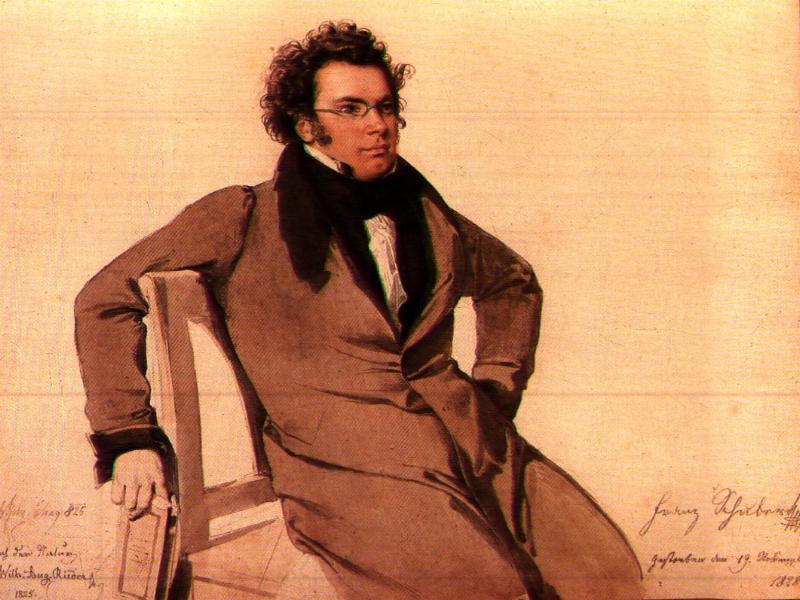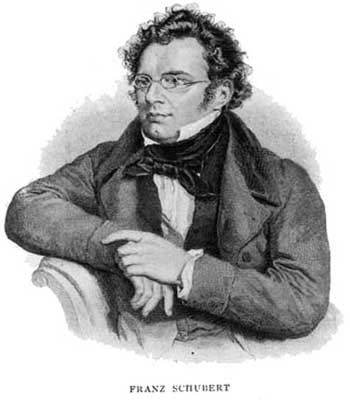<Back to Index>
- Musicologist Alan Lomax, 1915
- Composer Franz Peter Schubert, 1797
- President of the Federal Republic of Germany Theodor Heuss, 1884
PAGE SPONSOR
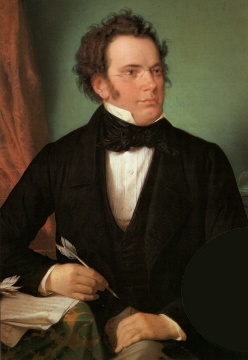
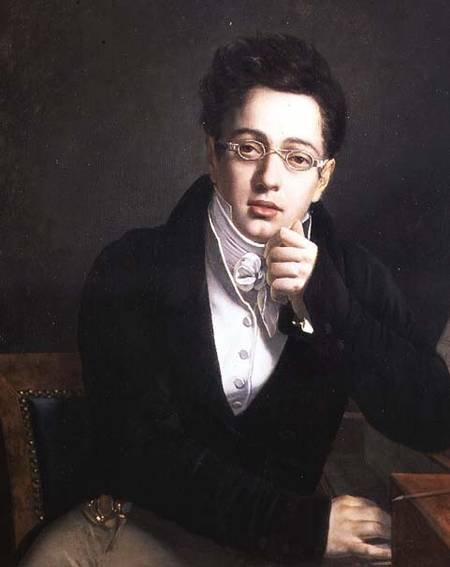
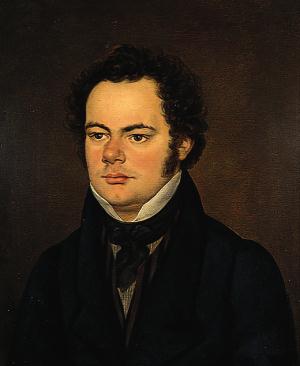
Franz Peter Schubert (January 31, 1797 – November 19, 1828) was an Austrian composer.
Although he died at an early age, Schubert was tremendously prolific. He wrote some 600 Lieder, nine symphonies (including the famous "Unfinished Symphony"), liturgical music, operas, some incidental music, and a large body of chamber and solo piano music. Appreciation of his music during his lifetime was limited, but interest in Schubert's work increased dramatically in the decades following his death at the age of 31. Franz Liszt, Robert Schumann and Felix Mendelssohn, among others, discovered and championed his works in the 19th Century. Today, Schubert is admired as one of the leading exponents of the Romantic era in music and he remains one of the most frequently performed composers.
Schubert was born in Himmelpfortgrund (now a part of Alsergrund), Vienna on January 31, 1797. His father, Franz Theodor Schubert, the son of a Moravian peasant, was a parish schoolmaster; his mother, Elisabeth Vietz, was the daughter of a Silesian master locksmith,
and had also been a housemaid for a Viennese family prior to her
marriage. Of Franz Theodor's fourteen children (one illegitimate child
was born in 1783), nine died in infancy; five survived. Their father was a well-known teacher, and his school in Lichtental, a part of Vienna's 9th district, was well attended. He was not a musician of fame or with formal training, but he taught his son some elements of music. At the age of five, Schubert began receiving regular instruction from his father and a year later was enrolled at his father's Himmelpfortgrund school. His formal musical education also began around the same time. His father continued to teach him the basics of the violin, and his brother Ignaz gave him piano lessons. At
7, Schubert began receiving lessons from Michael Holzer, the local
church organist and choirmaster. Holzer's lessons seem to have mainly
consisted of conversations and expressions of admiration and the boy gained more from his acquaintance with a friendly joiner's apprentice who used to take him to a neighboring pianoforte warehouse where he had the opportunity to practice on better instruments. He also played the viola in
the family string quartet, with brothers Ferdinand and Ignaz on violin
and his father on the cello. Schubert wrote many of his early string
quartets for this ensemble.
Schubert first came to the attention of Antonio Salieri, then Vienna's leading musical authority, in 1804, when his vocal talent was recognized. In
October 1808, he became a pupil at the Stadtkonvikt (Imperial seminary)
through a choir scholarship. At the Stadtkonvikt, Schubert was
introduced to the overtures and symphonies of Mozart. His exposure to these pieces and various lighter compositions, combined with his occasional visits to the opera set the foundation for his greater musical knowledge. One important musical influence came from the songs of Johann Rudolf Zumsteeg, who was an important Lied composer of the time, which, his friend Joseph von Spaun reported, he "wanted to modernize". Schubert's
friendship with Spaun began at the Stadtkonvikt and endured through his
lifetime. In those early days, the more well-to-do Spaun furnished the
impoverished Schubert with manuscript paper. Meanwhile,
his genius began to show in his compositions. Schubert was occasionally
permitted to lead the Stadtkonvikt's orchestra, and Salieri decided to
begin training him privately in musical composition and theory in these years. It
was the first germ of that amateur orchestra for which, in later years,
many of his compositions were written. During the remainder of his stay
at the Stadtkonvikt he wrote a good deal of chamber music, several
songs, some miscellaneous pieces for the pianoforte and, among his more ambitious efforts, a Kyrie (D. 31) and Salve Regina (D. 27), an octet for wind instruments (D. 72/72a, said to commemorate the 1812 death of his mother), a cantata for guitar and male voices (D. 110, in honor of his father's birthday in 1813), and his first symphony (D. 82). At
the end of 1813, he left the Stadtkonvikt, and returned home for
studies at the Normalhauptschule to train as a teacher. In 1814, he
entered his father's school as teacher of the youngest students. For
over two years, the young man endured the drudgery of the work, which
he performed with very indifferent success. There
were, however, other interests to compensate. He continued to receive
private lessons in composition from Salieri, who did more for
Schubert’s musical training than any of his other teachers. Salieri and
Schubert would part ways in 1817. In 1814, Schubert met a young soprano named Therese Grob, the daughter of a local silk manufacturer. Several of his songs (Salve Regina and Tantum Ergo) were composed for her voice, and she also performed in the premiere of his first Mass (D. 105) in September 1814. Schubert intended to marry Grob, but was hindered by the harsh marriage consent law of 1815, which required the ability to show the means to support a family. In November 1816, after failing to gain a position at Laibach, Schubert sent Grob's brother Heinrich a collection of songs, which were retained by her family into the 20th century. Schubert's
most prolific year was probably 1815. He composed over 20,000 bars of
music, more than half of which was for orchestra, including nine church
works, a symphony, and about 140 Lieder. In that year, he was also introduced to Anselm Hüttenbrenner and Franz von Schober, who would become his lifelong friends. Another friend, Johann Mayrhofer, was introduced to him by Spaun in 1814. Significant
changes happened in 1816. Schober, a student of good family and some
means, invited Schubert to room with him at his mother's house. The
proposal was particularly opportune, for Schubert had just made the
unsuccessful application for the post of Kapellmeister at Laibach,
and he had also decided not to resume teaching duties at his father's
school. By the end of the year, he became a guest in Schober's
lodgings. For a time, he attempted to increase the household resources
by giving music lessons, but they were soon abandoned, and he devoted
himself to composition. "I compose every morning, and when one piece is
done, I begin another." During this year, he focused on orchestral and choral works, although he also continued to write Lieder. Much of this work was unpublished, but manuscripts and copies circulated among friends and admirers. In early 1817, Schober introduced Schubert to Johann Michael Vogl,
a prominent baritone twenty years Schubert's senior. Vogl, for whom
Schubert went on to write a great many songs, became one of Schubert's
main proponents in Viennese musical circles. He also met Joseph
Hüttenbrenner (brother to Anselm), who also played a role in
promoting Schubert's music. These,
and an increasing circle of friends and musicians, became responsible
for promoting, collecting, and, after his death, preserving, his work. In
late 1817, Schubert's father gained a new position at a school in
Rossau (not far from Lichtental). Schubert rejoined his father and
reluctantly took up teaching duties there. In early 1818, he was
rejected for membership in the prestigious Gesellschaft der Musikfreunde, something that might have furthered his musical career. However,
he began to gain more notice in the press, and the first public
performance of a secular work, an overture performed in February 1818,
received praise from the press in Vienna and abroad. Schubert spent the summer of 1818 as music teacher to the family of Count Johann Karl Esterházy at their château in Zseliz (then in Hungary, now in Slovakia).
His duties were relatively light (teaching piano and singing to the two
daughters, Marie and Karoline), and the pay relatively good. As a
result, he happily continued to compose during this time. It may have
been at this time that he wrote one of his now world-famous
compositions, the Marche militaire No. 1 in D major. On his return from Zseliz, he took up residence with his friend Mayrhofer. The respite at Zseliz led to a succession of compositions for piano duet. The
tight circle of friends that Schubert surrounded himself with was dealt
a blow in early 1820. Schubert and four of his friends were arrested by
the Austrian secret police, who were suspicious of any type of student
gatherings. One of Schubert's friends, Johann Senn, was put on trial, imprisoned for over a year, and then permanently
banned from Vienna. The other four, including Schubert, were "severely
reprimanded", in part for "inveighing against [officials] with
insulting and opprobrious language". While
Schubert never saw Senn again, he did set some of his poems, "Selige
Welt" and "Schwanengesang", to music. The incident may have played a
role in a falling-out with Mayrhofer, with whom he was living at the
time. The compositions of 1819 and 1820 show a marked advance in development and maturity of style.
The unfinished oratorio "Lazarus" (D. 689) was begun in February;
later followed, amid a number of smaller works, by the 23rd Psalm
(D. 706), the Gesang der Geister (D. 705/714), the Quartettsatz in C minor (D. 703), and the "Wanderer Fantasy" for piano (D. 760). Of most notable interest is the staging in 1820 of two of Schubert's operas: Die Zwillingsbrüder (D. 647) appeared at the Theater am Kärntnertor on June 14, and Die Zauberharfe (D. 644) appeared at the Theater an der Wien on August 21. Hitherto,
his larger compositions (apart from his masses) had been restricted to
the amateur orchestra at the Gundelhof, a society which grew out of the
quartet parties at his home. Now he began to assume a more prominent
position, addressing a wider public. Publishers, however, remained distant, with Anton Diabelli hesitantly agreeing to print some of his works on commission. The
first seven opus numbers (all songs) appeared on these terms; then the
commission ceased, and he began to receive the meager pittances which
were all that the great publishing houses ever accorded to him. The
situation improved somewhat in March 1821 when Vogl sang "Der
Erlkönig" at a concert that was extremely well received. That month, he composed a variation on a waltz by Anton Diabelli (D. 718), being one of the fifty composers who contributed toVaterländischer Künstlerverein. The
production of the two operas turned Schubert's attention more firmly
than ever in the direction of the stage, where, for a variety of
reasons, he was almost completely unsuccessful. In 1822, Alfonso und Estrella was refused, partly owing to its libretto. Fierrabras (D. 796) was rejected in the fall of 1823, but this was largely due to the popularity of Rossini and the Italian operatic style, and the failure of Carl Maria von Weber's Euryanthe. Die Verschworenen (D. 787) was prohibited by the censor (apparently on the grounds of its title), and Rosamunde (D. 797)
was withdrawn after two nights, owing to the poor quality of the play
for which Schubert had written incidental music. Of these works, the
two former are written on a scale which would make their performances
exceedingly difficult (Fierrabras, for instance, contains over 1,000 pages of manuscript score), but Die Verschworenen is a bright attractive comedy, and Rosamunde contains some of the most charming music that Schubert ever composed. In 1822, he made the acquaintance of both Weber and Beethoven,
but little came of it in either case. Beethoven is said to have
acknowledged the younger man's gifts on a few occasions, but some of
this is likely legend and in any case he could not have known the real
scope of Schubert's music - especially not the instrumental works - as
so little of it was printed or performed in the composer's lifetime. On
his deathbed, Beethoven is said to have looked into some of the younger
man's works and exclaimed, "Truly, the spark of divine genius resides
in this Schubert!" but what would have come of it if he had recovered we can never know. In
the autumn of 1822, Schubert embarked suddenly on a work which more
decisively than almost any other in those years showed his maturing
personal vision, the "Unfinished Symphony" in B minor. The reason he
left it unfinished after two movements and sketches some way into a
third remains an enigma, and it is also remarkable that he didn't
mention it to any of his friends even though, as Brian Newbould notes, he must have felt thrilled by what he was achieving here.
In 1823 Schubert, in addition to Fierrabras, also wrote his first song cycle, Die schöne Müllerin (D. 795), setting poems by Wilhelm Müller. This series, together with the later cycle "Winterreise" (D. 911, also setting texts of Müller in 1827) is widely considered one of the pinnacles of Lieder. He also composed the song Du bist die Ruh ("You are stillness/peace") D. 776 during this year. Also in that year, symptoms of syphilis first appeared. In the spring of 1824 he wrote the Octet in F (D. 803), "A Sketch for a Grand Symphony"; and in the summer went back to Zseliz. There he became attracted to Hungarian musical idiom, and wrote the Divertissement à l'Hongroise (D. 818) for piano duet and the String Quartet in A minor (D. 804).
It
has been said that he held a hopeless passion for his pupil, the
Countess Karoline Eszterházy, but the only work he dedicated to
her was his Fantasie in F minor (D. 940) for piano duet. His friend Bauernfeld penned the following verse, which appears to reference Schubert's unrequited sentiments: In love with a Countess of youthful grace, Despite
his preoccupation with the stage, and later with his official duties,
he found time during these years for a significant amount of
composition. He completed the Mass in A flat (D. 678) and, in 1822, began the "Unfinished Symphony" (Symphony No. 8 in B minor, D. 759). Why the symphony was "unfinished" has been debated
endlessly without resolution. In 1824 he wrote the variations for flute
and piano on "Trockne Blumen", from the cycle Die schöne Müllerin, and several string quartets. He also wrote the Arpeggione Sonata (D. 821), at a time when there was a minor craze over that instrument.
The
setbacks of previous years were compensated for by the prosperity and
happiness of 1825. Publication had been moving more rapidly; the stress
of poverty was for a time lightened; and in the summer he had a
pleasant holiday in Upper Austria, where Schubert was welcomed with enthusiasm. It was during this tour that he produced his "Songs from Sir Walter Scott". This cycle contains Ellens dritter Gesang (D. 839), a setting of Adam Storck's German translation of Scott's hymn from The Lady of the Lake, which is widely, though mistakenly, referred to as "Schubert's Ave Maria". It opens with the greeting Ave Maria,
which recurs in the refrain; the entire Scott/Storck text in Schubert's
song is frequently substituted with the complete Latin text of the
traditional Ave Maria prayer. In 1825 Schubert also wrote the Piano Sonata in A minor (Op. 42, D. 845), and began the "Great" C major Symphony (Symphony No. 9, D. 944), which was completed the following year. From 1826 to 1828 Schubert resided continuously in Vienna, except for a brief visit to Graz in
1827. The history of his life during these three years was relatively
uneventful, and is little more than a record of his compositions. In
1826, he dedicated a symphony (D. 944, that later came to be known as the "Great") to the Gesellschaft der Musikfreunde and received an honorarium in return. In
the spring of 1828 he gave, for the first and only time in his career,
a public concert of his own works, which was very well received. The compositions themselves are a sufficient biography. The String Quartet in D minor (D. 810), with the variations on Death and the Maiden, was written during the winter of 1825 – 1826, and first played on January 25, 1826. Later in the year came the String Quartet in G major, (D. 887, Op. 161), the "Rondeau brilliant" for piano and violin (D. 895, Op. 70,), and the Piano Sonata in G (D. 894, Op. 78) (first published under the title "Fantasia in G"). To these should be added the three Shakespearian songs, of which "Hark! Hark! the Lark" (D. 889) and "An Silvia"
(D. 891) were allegedly written on the same day, the former at a
tavern where he broke his afternoon's walk, the latter on his return to
his lodging in the evening. In 1827 Schubert wrote the song cycle Winterreise (D. 911), a colossal peak of the art of art song ("remarkable" was the way it was described at the Schubertiades), the Fantasia for piano and violin in C (D. 934), the Impromptus for piano, and the two piano trios (the first in B flat (D. 898), and the second in E flat, D. 929); in 1828 the Mirjams Siegesgesang (Song of Miriam, D. 942) on a text by Franz Grillparzer, the Mass in E-flat (D. 950), the Tantum Ergo (D. 962) in the same key, the String Quintet in C (D. 956), the second Benedictus to the Mass in C, the last three piano sonatas, and the collection of songs published posthumously as Schwanengesang ("Swan-song", D. 957). This
collection, while not a true song cycle, retains a unity of style
amongst the individual songs, touching depths of tragedy and of the
morbidly supernatural which had rarely been plumbed by any composer in
the century preceding it. Six of these are set to words by Heinrich Heine, whose Buch der Lieder appeared in the autumn. The Symphony No. 9 (D. 944)
is dated 1828, but Schubert scholars believe that this symphony was
largely written in 1825–6 (being referred to while he was on holiday at
Gastein in 1825 - that work, once considered lost, now is generally
seen as an early stage of his C major symphony) and was revised for prospective performance in 1828. This
was a fairly unusual practice for Schubert, for whom publication, let
alone performance, was rarely contemplated for most of his larger scale
works during his lifetime. In the last weeks of his life he began to
sketch three movements for a new Symphony in D (D. 936A).
The
works of his last two years reveal a composer increasingly meditating
on the darker side of the human psyche and human relationships, and
with a deeper sense of spiritual awareness and conception of the
'beyond'. He reaches extraordinary depths in several chillingly dark
songs of this period, especially in the larger cycles. For example, the
song Der Doppelgänger reaching
an extraordinary climax, conveying madness at the realization of
rejection and imminent death - a stark and visionary picture in sound
and words that had been prefigured a year before by "Der Leiermann"
(The Hurdy-Gurdy Man) at the end of Der Winterreise -
and yet the composer is able to touch repose and communion with the
infinite in the almost timeless ebb and flow of the String Quintet and
his last three piano sonatas, moving between joyful, vibrant poetry and
remote introspection. Even in large scale works he was sometimes using
increasingly sparse textures; Newbould compares his writing in the
fragmentary Tenth Symphony (D.936A), probably the work of his very last
two months) with Mahler's use of folksong-like harmonics and bare
soundscapes. Schubert
expressed the wish, were he to survive his final illness, to further
develop his knowledge of harmony and counterpoint, and had actually made appointments for lessons with the counterpoint master Simon Sechter. In the midst of this creative activity, his health deteriorated. The cause of his death was officially diagnosed as typhoid fever, though other theories have been proposed, including the tertiary stage of syphilis. By the late 1820s Schubert's health was failing and he confided to some friends that he feared that he was near death. In
the late summer of 1828, the composer saw court physician Ernst Rinna,
who may have confirmed Schubert's suspicions that he was ill beyond
cure and likely to die soon. Some of his symptoms matched those of mercury poisoning (mercury was then a common treatment for syphilis, again suggesting that Schubert suffered from it). At
the beginning of November he again fell ill, experiencing headaches,
fever, swollen joints, and vomiting. He was generally unable to retain
solid food and his condition worsened. Schubert died in Vienna, at age
31, on November 19, 1828, at the apartment of his brother Ferdinand.
The last musical work he had wished to hear was Beethoven's String Quartet No.14 in C sharp minor, Op. 131; his friend, violinist Karl Holz, who was present at the gathering, 5
days before Schubert's death, commented: "The King of Harmony has sent
the King of Song a friendly bidding to the crossing". It
was next to Beethoven, whom he had admired all his life, that Schubert
was buried by his own request, in the village cemetery of Währing. In 1872, a memorial to Franz Schubert was erected in Vienna's Stadtpark. In 1888, both Schubert's and Beethoven's graves were moved to the Zentralfriedhof, where they can now be found next to those of Johann Strauss II and Johannes Brahms. The
cemetery in Währing was converted into a park in 1925, called the
Schubert Park, and his former grave site was marked by a bust.
— A pupil of Galt's; in desperate case
Young Schubert surrenders himself to another,
And fain would avoid such affectionate pother
